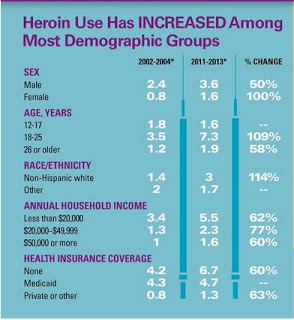CDC report finds heroin use increased by 63 percent since 2002, with greatest increases seen among women and whites

As heroin use has increased, so have heroin-related overdose deaths. Between 2002 and 2013, heroin-related overdose deaths nearly quadrupled, with more than 8,200 such deaths in 2013 nationwide. In Kentucky, 230 deaths were caused by heroin overdose in 2013, compared to 143 in 2012, according to the 2013 Overdose Fatality Report.
“Heroin use has increased rapidly across the U.S. and throughout society,” CDC Director Dr. Tom Frieden said in a media briefing. “The bottom line is this, heroin use is increasing rapidly across nearly all demographic groups, and with that increase we’re seeing a dramatic rise in deaths.”
 |
| Rate of heroin use per 1,000 people in each group Sources: National Survey on Drug Use and Health, National Vital Statistics System |
The report says that more than half a million Americans used heroin in 2013, representing nearly a 150 percent increase since 2007, and that those most at risk for heroin addiction are men, 18- to 25-year-olds, whites, people making less than $20,000, Medicaid recipients and the uninsured.
The greatest increases in heroin use between 2002 and 2013 were among groups that have historically had lower rates: women and non-Hispanic whites, with rates doubling among women and more than doubling among non-Hispanic whites. There was also “a significant increase” among those with private insurance and persons with higher incomes.
The report also found that nearly all people who reported using heroin also reported using at least one other drug and most used at least three other drugs.
 |
| Source: National Survey on Drug Use and Health, 2011-2013 |
People addicted to prescription painkillers were 40 times more likely to abuse heroin, cocaine users were 15 times more likely to use heroin. Marijuana users were three times more likely to use heroin, and alcohol users were two times more likely to use heroin.
Frieden said that this surge in heroin use is driven by the prescription drug epidemic and the increase in availability of heroin, which he estimates “costs roughly five times less than prescription opiates on the street.”
“It’s really a one-two punch,” Frieden said. “Those two factors we believe are driving the increase, and will drive the strategies we need to pursue to turn this around.”
Frieden called for “an urgent, all-of-society” response to combat this epidemic that includes states, public health, health care providers, families, communities and law enforcement .
“Our goal is to prevent people from starting to use heroin by reducing prescription opioid misuse, reduce heroin addiction by ensuring access to medication-assisted treatment, and reverse heroin overdose by exposing the use of Naloxone,” he said.
Kentucky passed a heroin law during the last legislative session to address several of these goals. The law includes a needle-exchange program, harsher penalties against traffickers, allocates money for drug-treatment programs, allows increased access to Naloxone, and allows jailers to provide medically assisted treatment for inmates with opiate addiction.